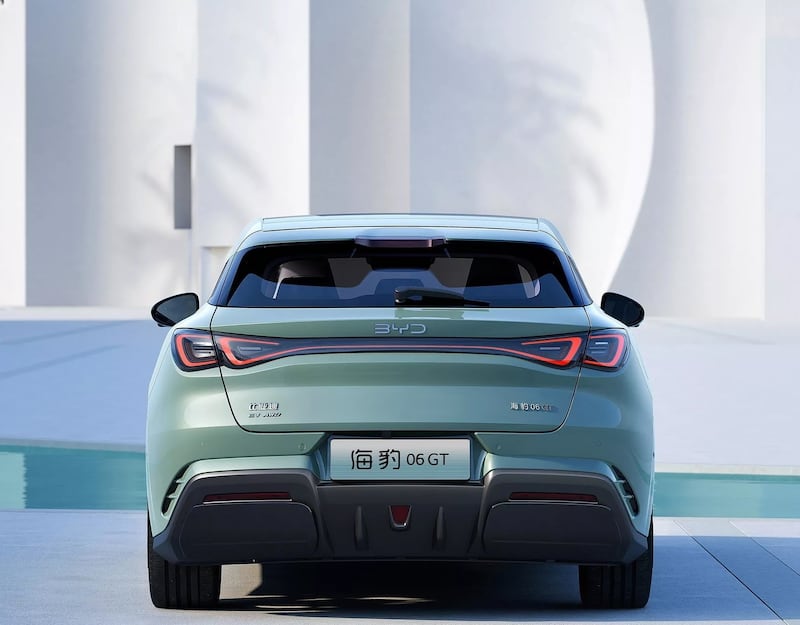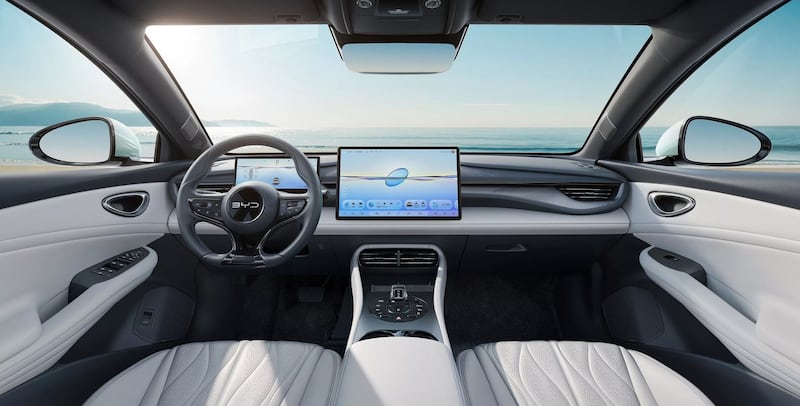Earlier this year, at the Beijing motor show, BYD showed off a bright orange concept hatchback with massive wings and a race-car-esque bodykit, called the Ocean M Concept. Actual hard details on the car were staggeringly thin on the ground at the time, but it was clear that BYD was taking aim at the likes of the VW ID.3, the Cupra Born, and the Renault Megane E-Tech with a five-door family electric hatch.
Well, now we know more, because here comes the Seal 06 GT, the full production version of the Ocean M concept. It’s the latest in a dramatic expansion of the Seal sub-brand for BYD. The four-door Seal saloon – a Tesla Model 3 and Polestar 2 rival – has been on sale for some time now and has already picked up an Irish Times car of the year award. The Seal-U DM-i plug-in hybrid SUV arrives in Ireland this October, and that will be quickly followed by the Sealion 07, an SUV version of the Seal saloon with similar styling by a roomier and more practical interior.
Underneath the sharp-looking five-door hatchback bodywork, the Seal 06 GT uses the same platform as the Seal saloon, and while BYD isn’t being exactly forthcoming with the tech details, that does mean that it should come with a choice of rear-wheel drive and four-wheel drive options. It also heavily implies that the bodykit on the Ocean M show car was not just for show – the four-wheel drive Seal saloon has 530hp and a 0-100km/h time of just 3.7 seconds.

The Seal 06 GT won’t have that much power, but data from China suggests that it will pack a significant 422hp for the four-wheel drive model, and a more sedate 215hp for the rear-wheel drive version.
READ MORE
There have been some styling changes relative to the concept version. The headlights keep the same overall shape, but the bumper and bonnet are a little more fussy and less clean. The concept’s ultra-thin rear-view camera door mirrors have been replaced by more conventional items.
Inside, the Seal 06 GT gets basically the same interior as the familiar Seal salon, but while the instrument screen and rotating infotainment screen are the same, the overall design is slightly different, as the Seal 06 GT hatchback gets a simpler, plainer dashboard with fewer swoops and swirls.
Size-wise, the Seal 06 GT is a little larger than its primary competition such as the VW ID.3 and the MG4, but it’s not as big as a Hyundai Ioniq 5. It’s basically about halfway between the existing Dolphin hatchback and the Seal saloon, and the price should be about halfway between those two cars too – all things being equal, it should have a starting price of between €30,000 and €35,000 when it arrives in Ireland next year.
While we wait for that, there’s also an updated version of the Seal saloon coming. The most obvious visual changes are in the cabin, where the swirly-swoopy dashboard has been replaced by a large full-width gloss black panel which includes the instrument panel and a display in front of the front seat passenger, even though the main infotainment screen remains a separate, rotating unit in the centre of the dash. There’s also a new four-spoke steering wheel and a sense of cleaner, crisper design to the interior.

More significant though are the changes underneath, where the Seal gets an updated version of the e-Platform 3.0 lithium-iron phosphate battery pack. This now gets much faster 800-volt charging – the current Seal runs on 400-volts and has a maximum DC fast charging speed of 150kW. The upgrade to 800-volts means that the maximum charging rate could well be doubled to 300kW on DC power, although BYD hasn’t yet confirmed that, merely saying that the 10-80 per cent charging time has been cut from 37 minutes to 25 minutes.
The battery pack also gets new capacities, ranging from a basic version with 61.44kWh of energy storage to a larger 80.64kWh pack. So far in Europe and Ireland, BYD has only marketed the larger battery pack (which currently has 82kWh). On the Chinese CLTC official test, the new version of the Seal has a range of up to 650km, but that will be much lower once it’s been though the WLTP test for Europe – expect it to be much closer to 500km.
This updated Seal retains its existing two-motor 530hp model, but the single-motor rear-drive version now gets a little more power, with up to 300hp available. Other modifications include thew addition of new Disus-C adaptive suspension, first seen on the much more expensive Yangwang luxury brand, a sister to BYD.
On the outside, the only significant change is the addition of a small hump above the windscreen, which isn’t a taxi light but a LIDAR (laser and radar combined) sensor which can 3D scan the road ahead of the Seal, and which is expected to allow for such systems as hands-off motorway driving and remote valet parking as and when these become legal in each market.
Will BYD be able to hold on to its sharp pricing in the face of the EU’s new tariffs on Chinese-made electric cars? So far, BYD’s vice-president, Stella Li, has given no indication that prices will rise, telling Le Journal de l’Automobile that: “We are patient, and we are building for the long term. Politicians are overreacting to the arrival of Chinese manufacturers. This is exactly what the Japanese OEMs experiences in the 1970s and 1980s, and after them, the Koreans. Today, nobody questions their presence in Europe. We want to achieve the same, by setting down roots in Europe and becoming a local company.”
BYD has already broken ground on a factory in Hungary, and has eyes on a second European plant, in spite of the slowdown in EV sales. Such factories would allow BYD to bypass the new tariffs, which have already been watered-down slightly – BYD’s original tariff has been fractionally reduced from 17.4 per cent to 17 per cent.















